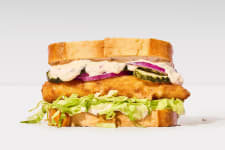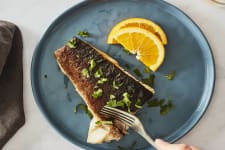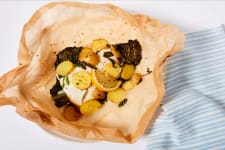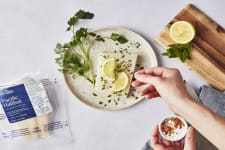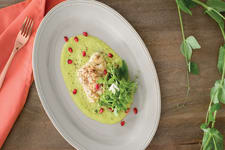
Smoky Shrimp Paella With Grilled Vegetables
May 20th, 2024A Spanish-Inspired Rice Dish for Summer
Paella, a classic Spanish rice dish, is the perfect meal to enjoy in the summer. Using sweet, buttery, sidestriped shrimp from Alaska elevates this recipe and makes it a great option for dinner under the stars. This recipe for grilled shrimp paella is not a traditional preparation, but it features some of paella’s signature elements — smoky flavors and great seafood.
Typically, paella is cooked in a thin, shallow pan over a burner that is specially designed for the dish. To adapt this recipe for an American grill, this paella is cooked as a few separate components. Short-grain rice is cooked in a heat-proof pan placed on the grill, allowing the base of the paella to infuse with smoky flavor. The addition of smoked paprika to the rice is essential in building up these flavors.
Meanwhile, summer veggies are grilled directly over the flame, while seasoned shrimp are cooked in foil packets until perfectly cooked through. The shrimp are also tossed in smoked paprika, which complements their sweetness. Each component of the paella is combined upon serving as a single plate of food.
Ingredients and Substitutions:
-
Short-grain rice: Look to buy a short-grain “paella rice” for this dish, which should have the right amount of starchiness and density to become perfectly chewy once cooked. Rice varieties like Bomba or Calasparra are ideal. If you’re not able to find these types of paella rice, an Italian risotto rice variety like Arborio can be substituted. Short-grain “sushi rice” can also work as a substitute.
-
Smoked paprika: Spanish “pimenton de la vera” is a smoked variety of paprika that is traditionally used in flavoring paella. However, in a pinch, any variety of paprika can be used, though the dish will not have as much smoky complexity.
-
Sidestriped shrimp: Wild-caught sidestriped shrimp are sweet and delicious, with a delicate texture that elevates this shrimp paella recipe. If substituting a different type of shrimp, make sure to choose a sustainably-sourced variety, like spot prawns. Also keep in mind that the average grocery store shrimp is often treated with chemical additives like sodium tripolyphosphate, which can leave behind a rubbery texture once the shrimp is cooked. If possible, only purchase shrimp that hasn’t been treated with these chemicals.
Smoky Shrimp "Paella" With Grilled Vegetables
By Wild Alaskan Company
Prep time
15 minutes
Cook Time
25 minutes
Total time
40 minutes
Yield
4 servings
Ingredients
- 2 (8 oz.) packs sidestriped shrimp or spot prawns, peeled
- 2 cups vegetable broth
- 1 (14.5 oz.) can fire-roasted crushed tomatoes
- 4 tablespoons extra-virgin olive oil, plus more for drizzling
- 1 tablespoon smoked paprika, divided
- 4 cloves garlic, thinly sliced
- Salt and freshly ground black pepper
- 1.5 cups short grain rice
- 12 green olives, quartered
- 1 medium zucchini, sliced lengthwise into ¼-inch planks
- 1 bell pepper, quartered and seeded
- 1 small red onion, cut into ½-inch rounds
- 2 tablespoons butter, cut into a few chunks
- 1 lemon, zested and cut into wedges
- 4 tablespoons parsley, roughly chopped
Instructions
1. Prepare a hot grill (500F). Make sure the grates are clean and lightly oiled.
2. Combine vegetable broth, tomatoes, olive oil, 1 ½ teaspoons smoked paprika, half of the sliced garlic, and 1 ½ teaspoons of salt in a medium oven-safe pan. Stir to combine. Place pan on one side of the grill, then close grill lid and cook until tomato mixture begins to simmer, 5 to 7 min. Adjust grill dials as needed to maintain 500F.
3. Carefully add rice and olives to the pan, stirring to combine. Close the grill lid and cook until liquid is absorbed, about 16 to 18 minutes.
4. Meanwhile, drizzle bell peppers, onions, and zucchini slices with olive oil, tossing to coat. Season with salt and pepper.
5. Layer two 18x12-inch pieces of foil together for the grill packet. Gently pat shrimp dry, then arrange in the center of the foil rectangle. Toss with remaining paprika, remaining garlic, and 2 tablespoons parsley. Season with salt and pepper, then top with butter. Fold foil into a pouch and seal.
6. When rice has been cooking for 10 minutes, place foil packets directly onto grill grates. Cook for about 7 to 8 minutes, until shrimp are cooked through. Meanwhile, arrange vegetables directly on the grill grate, then close lid. Allow to cook until tender, about 6 to 8 minutes, flipping once.
7. When rice is done, carefully remove from the grill, then cover and let stand for 5 minutes. NOTE: Pan handle will be very hot!
8. Meanwhile, cut the grilled vegetables into bite-sized pieces. Fluff the paella rice with a fork, then stir in vegetables and remaining parsley. Taste to adjust for seasoning. Divide rice evenly between four plates.
9. Carefully open foil pouch. Sprinkle lemon zest over shrimp, stirring to combine. Divide shrimp evenly between plates, along with any juices from packets. Serve immediately with a fresh lemon wedge.
Consuming raw or undercooked meats, poultry, seafood, shellfish, or eggs may increase your risk of food-borne illness, especially if you have a certain medical condition. The FDA recommends an internal temperature of 145°F for cooked fish.
